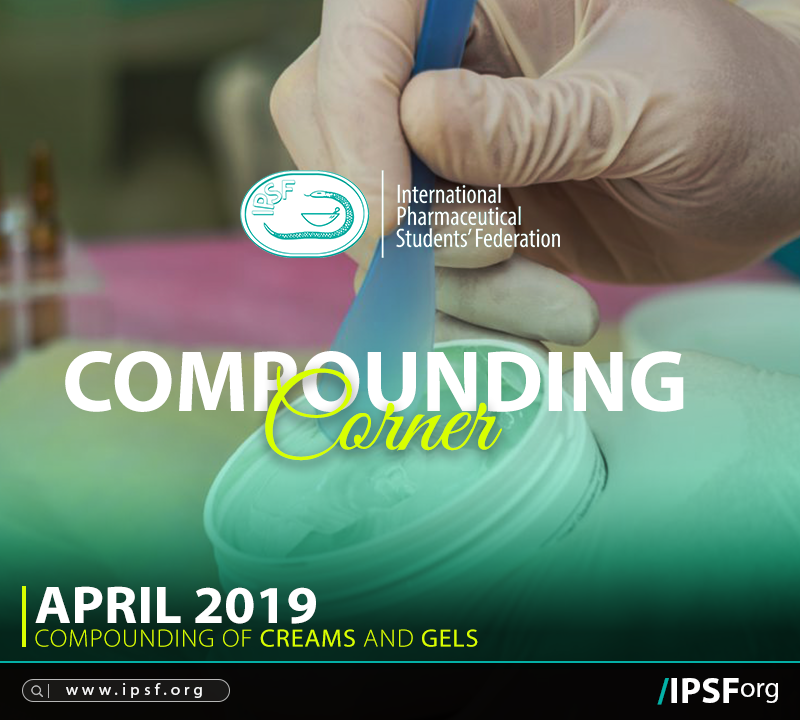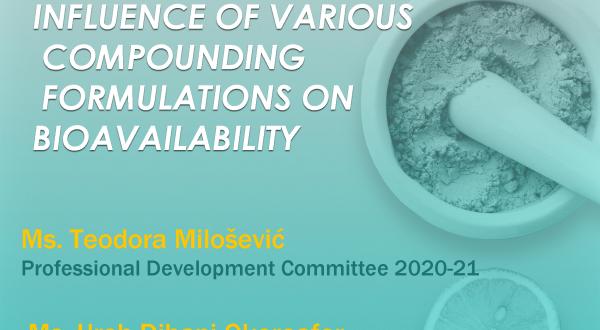
Compounding Corner April 2019: Compounding of Creams and Gels
CREAMS
Creams are multiphase preparations consisting of a lipophilic phase and an aqueous phase.
Lipophilic creams: Lipophilic creams have as the continuous phase (larger component) the lipophilic phase. They usually contain water-in-oil emulsifying agents such as lanolin, sorbitan esters and monoglycerides.
Hydrophilic creams: Hydrophilic creams have as the continuous phase (larger component) the aqueous phase. They contain oil-in-water emulsifying agents such as sodium or trolamine soaps, sulfated fatty alcohols, polysorbates and polyoxyl fatty acid and fatty alcohol esters combined, if necessary, with water-in-oil emulsifying agents.
Creams are semisolid dosage forms containing one or more drug substances dissolved or dispersed in a suitable base. This term has traditionally been applied to semisolids that possess a relatively fluid consistency formulated as either water-in-oil (e.g., Cold Cream) or oil in water (e.g., Fluocinolone Acetonide Cream) emulsions. However, more recently the term has been restricted to products consisting of oil-in-water emulsions or aqueous microcrystalline dispersions of long-chain fatty acids or alcohols that are water washable and more cosmetically and aesthetically acceptable. Creams can be used for administering drugs via the vaginal route (e.g., Triple Sulfa Vaginal Cream).
There are some advantages of cream preparations:
1. Easy to wash.
2. Not greasy.
3. Cream base contain large amounts of water so that can increase the release of the drug.
4. The surface tension of the skin will be lowered by the emulsifiers so that absorption is faster.
5. The cream is easy to use, provides good drug dispersion on the skin surface.
The choice of cream base depends on the drug, base compatibility, absorption: skin properties, blood flow and type of wound. The main consideration is the consistency of the expected dosage, the properties of the substance used and the basic requirements include: non-irritant, easy to clean, not left on the skin, stable not dependent on pH, homogenous with various drugs.
The cream base consists of a base type W / O and O / W emulsion;
· W / O type emulsion base. Example: lanolin, cold cream. The properties of the W / O type emulsion base are emollient, occlusive, contain water, some absorb added water, and oily.
· O / W type emulsion base. Example: hydrophilic ointment. The properties of the O / W type emulsion base are easily washed with water, not greasy, can be diluted with water, not occlusive.
During use, a continuous phase will evaporate, and increase the concentration of water soluble substances in the attached layer. To prevent the deposition of drugs, and to increase absorption through the skin, added substances that are mixed with water but do not evaporate, namely humectant (eg. propylene glycol). A better formulation is a cream that can deposit fat and other moisturizing compounds to help hydrate the skin.
The emulsion base consists of three components, namely the oil phase, water phase and emulsifier;
1. The oil phase, usually formed from petrolatum or liquid petrolatum with one or more high molecular weight alcohols such as cetyl or stearyl alcohol. Stearil alcohol and petrolatum form the oil phase which has the purpose of softening and making the skin comfortable. Stearyl alcohol also acts as an emulsifying adjuvant.
2. The water phase contains preservatives, emulsifiers or parts of emulsifiers and humectants. Humectants are usually in the form of glycerin, propylene glycol or polyethylene glycol. The water phase can also contain water-soluble components from the emulsion system, along with other additives such as stabilizers, antioxidants, buffers etc.
3. Emulsifier, The ideal emulsifiers must stable, inert, free of toxic and irritant ingredients, odorless, tasteless and colorless, produces a stable emulsion of the desired type. The emulsifying agent consists of anionic emulsifiers (eg. sodium lauryl sulfate, TEA stearic), cationic (eg. quaternary ammonium salt) and nonionic emulsifiers (eg. Tween, Span, etc.). The main consideration in choosing an emulsifiers is the comparison of hydrophilic and lipophilic groups. Hydrophilic Lipophilic Balance (HLB) is a measure of the balance of the state of lipophilic and hydrophilic which is a characteristic of the surfactant group emulsifiers.
After selecting the right component, the emulsion base is made through a heating and stirring process;
1. The oil phase is melted and heated in a container equipped with an agitator (stirrer) with various stirring speeds.
2. The emulsifying water phase is put in the second container, then dissolved and heated to a temperature of 75° C.
3. The water phase is then added while continuing to stir into the oil phase until homogenous and the temperature reaches around 30° C.
4. The active substance is usually added after the emulsion has been formed.
5. The finished cream is inserted into the tube as much as needed.
6. The tube is closed and then labeled and packaged in a box equipped with brochures and etiquette.
GELS
Gels consist of liquids gelled by means of suitable gelling agents.
Lipophilic gels: Lipophilic gels (oleogels) are preparations whose bases usually consist of liquid paraffin with polyethylene or fatty oils gelled with colloidal silica or aluminium or zinc soaps.
Hydrophilic gels: Hydrophilic gels (hydrogels) are preparations whose bases usually consist of water, glycerol or propylene glycol gelled with suitable gelling agents such as poloxamers, starch, cellulose derivatives, carbomers and magnesium-aluminium silicates.
Gels (sometimes called Jellies) are semisolid systems consisting of either suspensions made up of small inorganic particles or large organic molecules interpenetrated by a liquid.
Where the gel mass consists of a network of small discrete particles, the gel is classified as a two-phase system (e.g., Aluminum Hydroxide Gel). In a two-phase system, if the particle size of the dispersed phase is relatively large, the gel mass is sometimes referred to as a magma (e.g., Bentonite Magma). Both gels and magmas may be thixotropic (an isothermal and comparatively slow recovery, on standing of a material, of a consistency lost through shearing), forming semisolids on standing and becoming liquid on agitation. They should be shaken before use to ensure homogeneity and should be labeled to that effect.
Single-phase gels consist of organic macromolecules uniformly distributed throughout a liquid in such a manner that no apparent boundaries exist between the dispersed macromolecules and the liquid. Single-phase gels may be made from synthetic macromolecules (e.g., Carbomer) or from natural gums (e.g., Tragacanth). The latter preparations are also called mucilages. Although these gels are commonly aqueous, alcohols and oils may be used as the continuous phase. For example, mineral oil can be combined with a polyethylene resin to form an oleaginous ointment base. Gels can be used to administer drugs topically or into body cavities (e.g., Phenylephrine Hydrochloride Nasal Jelly).
There are some advantages of gel preparations;
a. Has a thixotropic and pseudoplastic flow, which is a solid gel if stored will melt immediately if shaken.
b. The concentration of gelling agent that required to form the gel is low.
c. Viscosity of the gel does not undergo significant changes in storage at room temperature.
d. For hydrogels: have a cooling effect on the skin when used; the appearance of clear and elegant preparations, the use on the skin after drying leaves the film translucent, elastic, high adhesion that does not clog the pores, easily washed with water, good drug release, the ability to spread on the skin is good.
Some of the properties and characteristics of the gel include;
1. Gelling agents that are ideal for pharmaceutical preparations and cosmetics are inert, safe and do not react with other components.
2. The choice of gelling agent must provide a good solid form during storage but can be broken immediately when the preparation is given strength or power caused by shaking in a bottle, squeezing a tube, or during topical use.
3. The characteristics of the gel must be adjusted to the intended use of the dosage form.
4. The use of gelling agent with very high concentration or large molecular weight can produce a gel that is difficult to remove or use.
5. The formation of the gel can be through reducing and increasing the temperature. For example polymers such as MC, HPMC can dissolve only in cold water which will form a thick solution and at an increase in temperature the solution will form a gel. The phenomenon of gel formation or phase separation caused by heating is called thermogelation.
6. Swelling. The gel can expand because the gelling agent can absorb the solution so that volume increases. The solvent will penetrate between the gel matrix and there will be interaction between the solvent and the gel. Gel development is less perfect if crosslinking between polymers in the gel matrix occurs which can cause the solubility of the gel component to decrease.
7. Sineresis. A process that occurs due to contractions in the gel mass. The entangled liquid will come out and be above the gel surface. At the time of gel formation elastic pressure occurs, so that a solid gel mass is formed. The mechanism of contraction is related to the phase of relaxation due to the elastic pressure when the gel is formed. The change in gel toughness will cause the distance between the matrices to change, allowing the liquid to move towards the surface. Sineresis can occur in hydrogels (a gel in which the liquid component is water) or organogels (a gel in which the liquid component is organic solvent).
General gel-making procedure;
1. Weigh the gelling agents as needed
2. Gelling agents are expanded according to their own methods
3. Weigh the active ingredients and other additives
4. Add the gelling agent that has been expanded into the mixture while stirring constantly until it is homogeneous but not too strong because it will absorb air, causing air bubbles to appear in the preparation which can affect the pH of the preparation.
5. The finished gel is inserted into the gel filler and loaded into the tube as much as needed
6. The tube is closed and then labeled and packaged in a box equipped with brochures and etiquette
References
-
Allen, L. V., Popovich, N. G., Ansel, H. C., & Ansel, H. C. (2005). Ansel's pharmaceutical dosage forms and drug delivery systems. Philadelphia: Lippincott Williams & Wilkins.
-
British Pharmacopoeia Commision. (2013). British Pharmacopoeia. London: The. Pharmaceutical Press.
-
Christopher A Langley, Dawn Belcher. (2012) FASTtrack: Pharmaceutical Compounding and Dispensing. London: Pharmaceutical Press.
-
Marriott J F, Wilson K A, Langley C A, Belcher D (2006) Pharmaceutical Compounding and Dispensing. London: Pharmaceutical Press.
-
Sinko, P. J., & Martin, A. N. (2006). Martin's physical pharmacy and pharmaceutical sciences: Physical chemical and biopharmaceutical principles in the pharmaceutical sciences. Philadelphia: Lippincott Williams & Wilkins.
-
USP 39-NF 34 (2016) United States Pharmacopeia
-----------------------------------------------------------------------------------------
Case
Mr. X, 28 years-old, comes into your pharmacy with a prescription:
- Neomycin Sulfate 1%
- Hydrocortisone 1%
Make cream 30 g
Apply twice daily.
Your pharmacy have a cream formulation:
- Vaseline Album 25% (RHLB:12)
- Cetyl Alcohol 20% (RHLB:15)
- Emulsifying agents 5%
- Tween 20 (HLB:16,7)
- Span 20 (HLB:8,6)
- Metil paraben 0,18%
- Aquadest ad 100%
*) HLB : Hydrophilic Lipophilic Balance
*) RHLB : Required Hydrophilic Lipophilic Balance
Please make compounding log sheet!
Template of compounding log sheet can be found here
The answer can be found here



